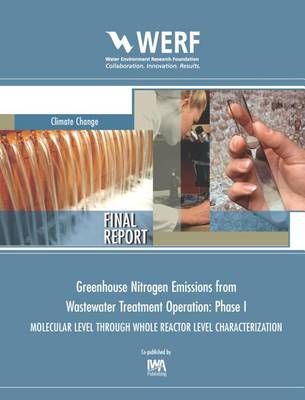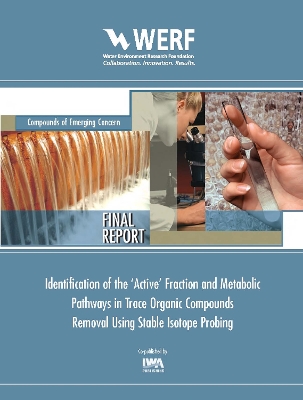WERF Research Report
2 total works
Greenhouse Nitrogen Emissions from Wastewater Treatment Operation
by Kartik Chandran
Published 14 January 2013
Available as eBook only.
Engineered biological nutrient removal (BNR) processes are used mainly to achieve improved water quality. However, BNR strategies could be a potential contributor to atmospheric nitrous oxide (N2O) emissions depending on reactor configurations and operating conditions. In the future, as BNR is implemented at wastewater treatment plants (WWTPs) around the nation, the flux of this greenhouse gas (GHG) to the atmosphere could increase. Increased releases would be of possible concern because the greenhouse impact of N2O on a mass equivalent basis is about 300 times that of carbon dioxide.
This project represents one of the first attempts to characterize thoroughly nitrogenous greenhouse gas (N-GHG) emissions from WWTPs and to develop a methodology to collect full-scale plant data from BNR facilities in the United States. Building on previous work by the project team, this information will be integrated into mechanistic activated sludge process models, which will be refined through this project by the addition of autotrophic pathways for N2O and NO emissions. The refined mechanistic models will allow the industry to codify the results of this research and develop a tool that will aid in the prediction and, therefore, mitigation of N2O and NO emissions from WWTPs using a range of wastewater treatment processes. Ultimately, this would allow the wastewater sector to engineer strategies for wastewater treatment that minimize gaseous nitrogen oxide emissions.
This study is the first of its kind in the United States, and replaces the Interim Report. Only two other similar studies have been conducted in the Netherlands and Australia. To facilitate a global monitoring effort, the protocol developed in this study was shared upon request with additional groups in Spain, Portugal, Germany, Singapore, South Korea, and Belgium, which are just beginning similar monitoring programs. It is expected that broad application of the protocol will allow WWTPs to quantify their N2O emissions using a standard analytical approach. Because plant operations have a key role in N2O emissions, this report provides significant insight towards the mechanisms influencing emissions and direction to ultimately engineer environmentally sustainable BNR operating strategies and configurations.
Engineered biological nutrient removal (BNR) processes are used mainly to achieve improved water quality. However, BNR strategies could be a potential contributor to atmospheric nitrous oxide (N2O) emissions depending on reactor configurations and operating conditions. In the future, as BNR is implemented at wastewater treatment plants (WWTPs) around the nation, the flux of this greenhouse gas (GHG) to the atmosphere could increase. Increased releases would be of possible concern because the greenhouse impact of N2O on a mass equivalent basis is about 300 times that of carbon dioxide.
This project represents one of the first attempts to characterize thoroughly nitrogenous greenhouse gas (N-GHG) emissions from WWTPs and to develop a methodology to collect full-scale plant data from BNR facilities in the United States. Building on previous work by the project team, this information will be integrated into mechanistic activated sludge process models, which will be refined through this project by the addition of autotrophic pathways for N2O and NO emissions. The refined mechanistic models will allow the industry to codify the results of this research and develop a tool that will aid in the prediction and, therefore, mitigation of N2O and NO emissions from WWTPs using a range of wastewater treatment processes. Ultimately, this would allow the wastewater sector to engineer strategies for wastewater treatment that minimize gaseous nitrogen oxide emissions.
This study is the first of its kind in the United States, and replaces the Interim Report. Only two other similar studies have been conducted in the Netherlands and Australia. To facilitate a global monitoring effort, the protocol developed in this study was shared upon request with additional groups in Spain, Portugal, Germany, Singapore, South Korea, and Belgium, which are just beginning similar monitoring programs. It is expected that broad application of the protocol will allow WWTPs to quantify their N2O emissions using a standard analytical approach. Because plant operations have a key role in N2O emissions, this report provides significant insight towards the mechanisms influencing emissions and direction to ultimately engineer environmentally sustainable BNR operating strategies and configurations.
U2R12
The widespread presence of trace organic contaminants (TOrC), such as the endocrine disrupting compound bisphenol-A (BPA), has been cause for growing concern due to persistence in the environment and potential ecological impacts. Despite progress made in understanding the removal of TOrC in biological wastewater treatment processes, there is still a lack of consensus regarding the identity of microorganisms active in biodegradation and the exact removal mechanisms involved. This research aimed to develop a clear understanding of the microbial 'active' fraction in activated sludge which is responsible for the assimilation of a selected TOrC, BPA. Through the use of DNA stable isotope probing (DNA-SIP), BPA assimilating organisms were identified. This active fraction of BPA assimilation included bacteria related to Sphingobium spp., Sphingomonas spp., Pussilimonas spp., and Variovorax spp.. Results from this work also confirm that prior or time-course exposure to BPA as well as bioreactor process conditions influence microbial community structure and function. Added understanding of TOrC removal mechanisms could be derived through continued investigation into microbial functions associated with BPA removal.

